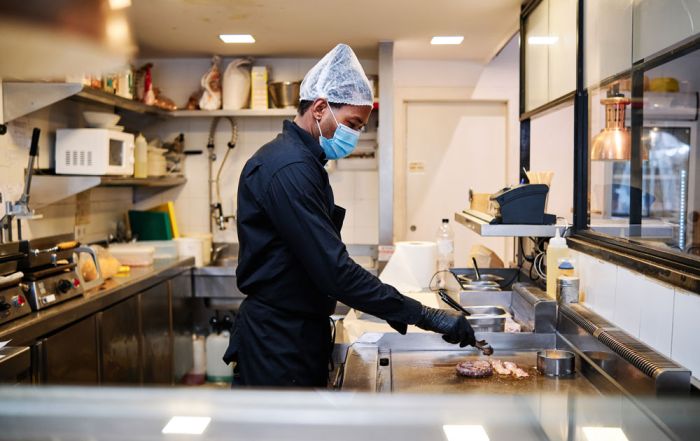Food Storage for Food Safety -And Quality!
Smart operators know that the way food is packaged and stored will affect the safety and quality of the product. Food that is poor quality frequently gets tossed, upping costs. Paying attention to storage materials and packaging is a best practice to maintain food quality. The lines between food processors and foodservice are blurring. It seems more and more foodservices are using in-house processing techniques, whether through smoking meats, use of sous vide, cook-chill, or preservation of summer produce as many farm to foodservice programs do. It is critical that proper packaging materials and processes be used.
In this blog, we will focus on considerations when communicating with vendors. Later in the month, we will address the types of food storage materials that will best maintain the safety and quality of foods.
Those in charge of purchasing food should consider the quantity needed and the packaging materials. Most of us appreciate “value buys” – I know I have on more than one occasion purchased a super-sized container of food (yes, the movie theater popcorn!) only to end up wasting some of it. Buying the “just right” amount can be tricky – that is why taking precautionary steps to ensure shelf life can prevent food loss. Food processors have their processes down pretty well. So, a foodservice might consider purchasing individually quick frozen units of meats or entrees compared to bulk packaging. The same amount can be purchased, but the individual packages gives more flexibility for use. While there may be a slightly higher unit cost, product quality and safety will be maintained.
The person who makes food buying decisions should also think about whether the packaging will protect the food from point of production to delivery at your foodservice. For some foods, proper pack and storage of the item will have a big impact on the quality when it is delivered. One example is tray packed fiberboard cases of fresh apples to protect from bruising during transit.
Food Code 2017 (and past versions) references food package materials in Chapter 3.
3-202.15 Package Integrity
Food packages shall be in good condition and protect the integrity of the contents so that the FOOD is not exposed to ADULTERATION of potential contaminants.
The Food and Drug Administration (in the Code of Federal Regulations or CFR) provide guidance to food processors about package materials to protect integrity of the food. These are food grade materials. Many food manufacturers use food grade plastics as the package container. Recognize there are different formulas for different types of plastics. Processors carefully determine the best package material to use to protect quality and safety of food. Note that plastic containers used as a food package are intended as Single Use Items, these are NOT intended for re-use as a food storage container. Food Code prohibits re-use of single use items by foodservices. Now at home, that is a different story – (Who hasn’t used cleaned margarine containers to store leftovers?). However, in foodservices, we have a responsibility for the public’s health. The issue is that the plastics break down during repeated cleaning and sanitizing. The degradation is known as “crazing”.
As the buyer, you need to be alert to the packaging used. We found in our early days with farm to school projects, local growers were using plastic garbage bags to transfer lettuce greens to the schools. They were not aware that those garbage bags are treated with chemicals to reduce odors and ward off pests. They are not intended for food contact. While most foodservice suppliers know the importance of packaging, there may be a need to communicate with local food suppliers.
Be present when food is delivered so that packages can be checked for any evidence of damage or tampering, and to verify that the package contents is reflected on the label. Also check that quality and quantity of what was ordered was delivered. These actions demonstrate that your operation has taken reasonable care to ensure safety of the food.
Risk Nothing!
READ MORE POSTS
Don’t Underestimate the Importance of Employee Health as we head into the Winter Months
Early this month, I ran across an article discussing an outbreak investigation in the Australian Capital Territory. The outbreak caused more than 200 people to fall ill and was one of the most widespread outbreak investigations in the history of the territory. The cause was traced back to Norovirus, a virus I am sure you have heard us opine about in this blog before.
Exclusion and Restrictions: Understanding Employee Health and the Food Code
I received a call earlier in the month from a foodservice operator who suspected that one of their employees may have fallen ill and wondered if they had to send the employee home for the day. Once I started to ask a few more questions, it became obvious that the operator wasn’t really in-tune with the food code requirements on restrictions or exclusions for employees who may not be feeling well. Given that most operations are dealing with staff shortages currently and the fact that we are about to head into the fall and winter – when we tend to see an increase in upper respiratory and other illnesses, such as the flu - it seemed like a very timely and important topic for the blog this month.
Cross Contamination and the Surfaces that go Unnoticed
In October, I ran across a new research study published in the Journal of Food Protection in early-September. The article explored cross contamination in consumer kitchens during meal preparation. One of the authors was a previous SafeBites presenter, Dr. Ellen Shumaker, at North Carolina State University. Although the setting was consumer kitchens and not the commercial kitchen many of you deal with daily, the findings were very applicable to what we often see in the foodservice setting.
Emergency Preparedness: The Not-so Calm After the Storm
If you and your foodservice operation have been hit by an emergency or other disaster, what comes next and how do you move forward? Much of the answer to this is predicated on the actual disaster that you are dealing with – a flood is certainly a much different than a fire, but some of the food safety considerations remain the same if your business has been left intact and has not been damaged by the disaster.










